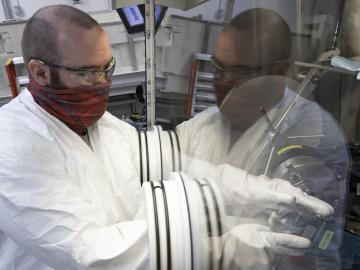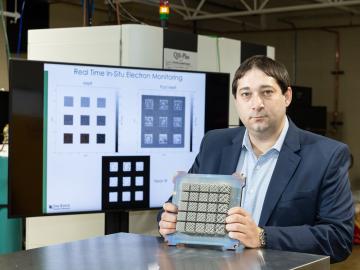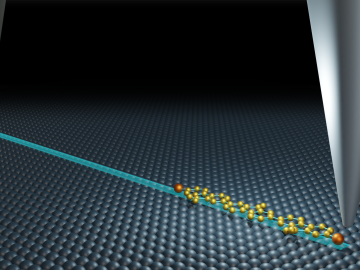
Filter News
Area of Research
- Advanced Manufacturing (7)
- Biology and Environment (63)
- Computational Biology (2)
- Computational Engineering (1)
- Computer Science (4)
- Energy Science (82)
- Fuel Cycle Science and Technology (1)
- Fusion and Fission (7)
- Fusion Energy (7)
- Isotopes (4)
- Materials (66)
- Materials for Computing (14)
- National Security (34)
- Neutron Science (25)
- Nuclear Science and Technology (12)
- Nuclear Systems Modeling, Simulation and Validation (1)
- Quantum information Science (1)
- Supercomputing (48)
- Transportation Systems (2)
News Type
News Topics
- (-) Advanced Reactors (26)
- (-) Artificial Intelligence (94)
- (-) Biology (102)
- (-) Composites (22)
- (-) Materials Science (98)
- (-) Nanotechnology (33)
- (-) National Security (66)
- (-) Polymers (21)
- (-) Security (19)
- (-) Space Exploration (23)
- (-) Transportation (71)
- 3-D Printing/Advanced Manufacturing (93)
- Big Data (67)
- Bioenergy (86)
- Biomedical (55)
- Biotechnology (29)
- Buildings (55)
- Chemical Sciences (50)
- Clean Water (31)
- Computer Science (159)
- Coronavirus (31)
- Critical Materials (18)
- Cybersecurity (17)
- Education (2)
- Emergency (4)
- Energy Storage (69)
- Environment (172)
- Exascale Computing (52)
- Fossil Energy (7)
- Frontier (46)
- Fusion (49)
- Grid (56)
- High-Performance Computing (94)
- Hydropower (12)
- Irradiation (2)
- Isotopes (40)
- ITER (7)
- Machine Learning (54)
- Materials (89)
- Mathematics (12)
- Mercury (10)
- Microelectronics (3)
- Microscopy (38)
- Molten Salt (7)
- Neutron Science (112)
- Nuclear Energy (90)
- Partnerships (37)
- Physics (43)
- Quantum Computing (39)
- Quantum Science (60)
- Simulation (53)
- Software (1)
- Statistics (3)
- Summit (48)
Media Contacts

Oak Ridge National Laboratory researchers have demonstrated that a new class of superalloys made of cobalt and nickel remains crack-free and defect-resistant in extreme heat, making them conducive for use in metal-based 3D printing applications.

On Feb. 18, the world will be watching as NASA’s Perseverance rover makes its final descent into Jezero Crater on the surface of Mars. Mars 2020 is the first NASA mission that uses plutonium-238 produced at the Department of Energy’s Oak Ridge National Laboratory.

A better way of welding targets for Oak Ridge National Laboratory’s plutonium-238 production has sped up the process and improved consistency and efficiency. This advancement will ultimately benefit the lab’s goal to make enough Pu-238 – the isotope that powers NASA’s deep space missions – to yield 1.5 kilograms of plutonium oxide annually by 2026.

Collaborators at Oak Ridge National Laboratory and the University of Tennessee Health Science Center are developing a breath-sampling whistle that could make COVID-19 screening easy to do at home.

Growing up in the heart of the American automobile industry near Detroit, Oak Ridge National Laboratory materials scientist Mike Kirka was no stranger to manufacturing.


Oak Ridge National Laboratory’s Center for Nanophase Materials Sciences contributed to a groundbreaking experiment published in Science that tracks the real-time transport of individual molecules.

Fuel economy can take a tumble when temperatures plummet, according to the Department of Energy’s 2021 Fuel Economy Guide. Compiled by researchers at Oak Ridge National Laboratory, the guide includes several tips to improve a vehicle’s fuel performance.

Algorithms developed at Oak Ridge National Laboratory can greatly enhance X-ray computed tomography images of 3D-printed metal parts, resulting in more accurate, faster scans.

As Hurricane Dorian raged through the Bahamas, researchers at Oak Ridge National Laboratory worked around the clock to aid recovery efforts for one of the Caribbean’s worst storms ever.


